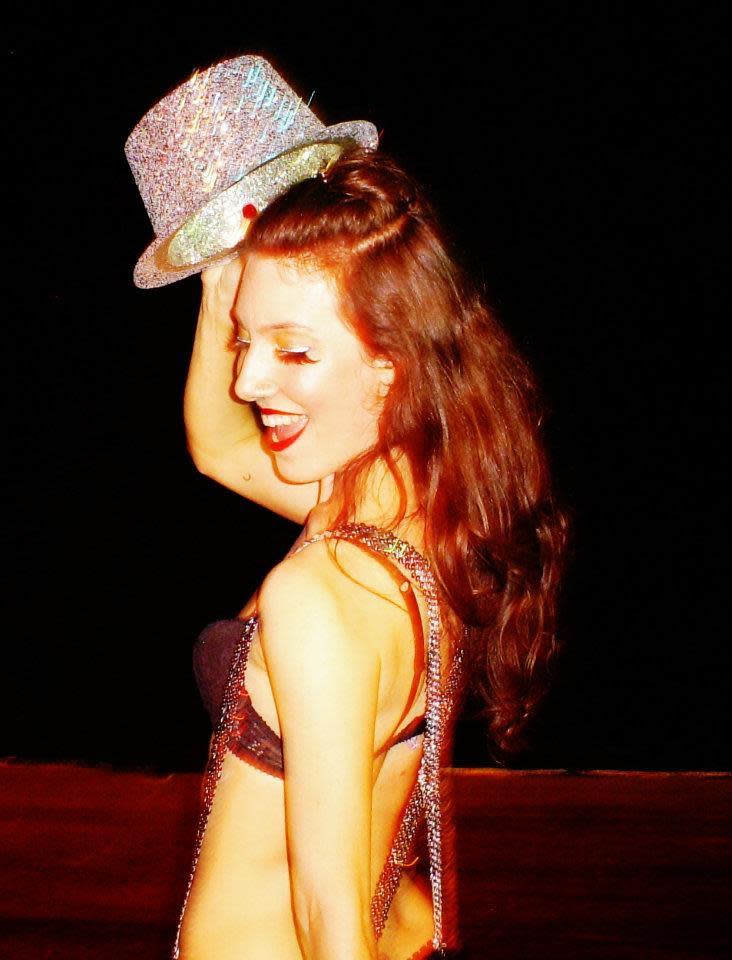How Burlesque Taught a Former Ballerina to Truly Love Her Body
Melinda Miller-Klopfer, now 30, was a highly accomplished ballerina with an enviable figure. But despite the adulation she received, she struggled with body image for years, constantly aspiring to be even thinner than she was and battling anorexia — all to appear perfect in her own mind and in front of an audience.
Truly loving and owning her body was something she didn’t know until 2010, when she attended a burlesque troupe performance in Berlin, Germany. She experienced the kind of epiphany that allowed her to throw off the mental shackles that bound her and feel a sense of ownership and empowerment with regard to her own body.
That feeling, she says, is at the core of burlesque.

Melinda Miller-Klopfer performing burlesque. (Photo: Veronique Von Spanque)
Instant Liberation
From the very first moment she walked out on stage to perform burlesque, Miller-Klopfer felt free from all that had held her back in her ballerina days.
“No one was yelling at me to lose two pounds or cinching me into a tutu,” the Gualala, California, resident tells Yahoo Health. “The crowd was roaring and I got the feeling that they loved me just as I was,”
Being able to take off her clothes and strip down to a thong and pasties had nothing to do with having a ballerina’s taut body. On the contrary, “to have my hips celebrated, rather than my boyishness, was huge and totally liberating,” she says. “All the other burlesque dancers I talked to felt the same way — that they were being celebrated as women, rather than being punished.”
Burlesque dancing, Miller-Klopfer says, is the ultimate female empowerment. For her, the act of removing one’s clothes on a stage in front of an audience is not about pleasing men. Although it titillates, it is not intended to be either exploitative nor degrading to a woman because to a burlesque dancer, dance is an art form. The dancers totally own their act and their bodies.
“We’re totally comfortable in our skins and as we are, and we invite others to be a part of that joy,” she says.
For her Mendocino County-based burlesque dance troupe formed in 2011, Les Filles Rouges, Miller-Klopfer — who, as an homage to French feminist Simone de Beauvoir, performs under the stage name Simone de Boudoir — enlisted a bunch of her closest friends. These women all have day jobs and aside from Miller-Klopfer, none of them are formally trained in dance. Some of them have cellulite; others have stretch marks and love handles.

Melinda Miller-Klopfer, Elika Freeman and Callie Dailey performing burlesque. (Photo: C. Young)
Although American women are theoretically liberated, Miller-Klopfer argues that many women in the U.S. are not as free as they believe themselves to be. Even the strongest of women are conditioned by media images of how a woman should look, she says — even if it’s an unrealistic size 2.
“What we’re doing is what everyone does when no one is watching — dancing in our living rooms in our underwear,” Miller-Klopfer says. “Unlike in ballet, where a dancer is on a pedestal and somehow viewed as someone doing something unattainable, burlesque forms a bond between dancer and audience. There’s a connection that’s formed from seeing a woman on stage who is comfortable in her body and an appreciation for what she has and who she is.”
Inspiring Others to Own Their Bodies
Miller-Klopfer isn’t just hoping to inspire American women to love their own bodies — she even traveled to the town of Forbesganj, India, in 2011 to help teach dance (not burlesque) to girls who had escaped child prostitution. She was determined to effect even the smallest shift in perspective in these children.
Indeed, the realization came to each of the girls in different ways — through something as simple as the awareness of their hands and the different ways in which they could move them; by standing in a circle and moving gently to the music; by turning a full cartwheel, their colorful dupattas (headscarves) falling into their eyes as they laughed with joy.
“My objective was for the girls to become aware of their bodies in a new way,” Miller-Klopfer explains. The goal: For them to “understand that their bodies belonged to them, and no one could make them do what they didn’t want to do with their bodies.”
“[I wanted them to] learn that their bodies could be a source of joy.”
Body-Peace Resolution is Yahoo Health’s January initiative to motivate you to pursue wellness goals that are not vanity-driven, but that strive for more meaningful outcomes. We’re talking strength, mental fitness, self-acceptance — true and total body peace. Our big hope: This month of resolutions will inspire a body-peace revolution. Want to join us? Start by sharing your own body-positive moments on social media using the hashtag #bodypeaceresolution


